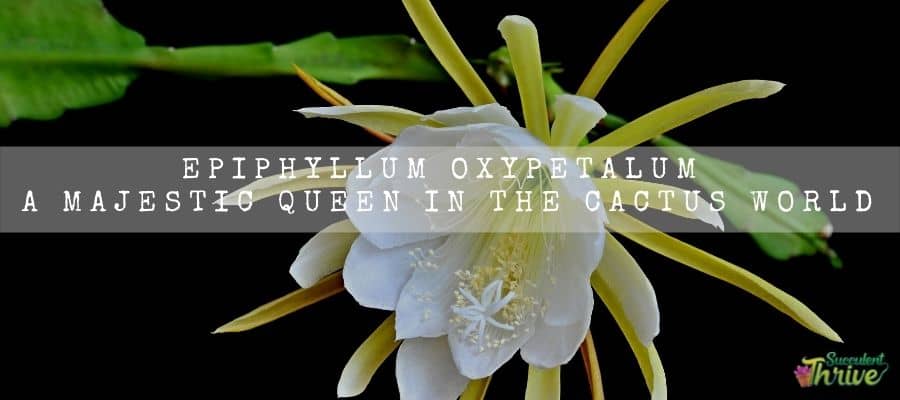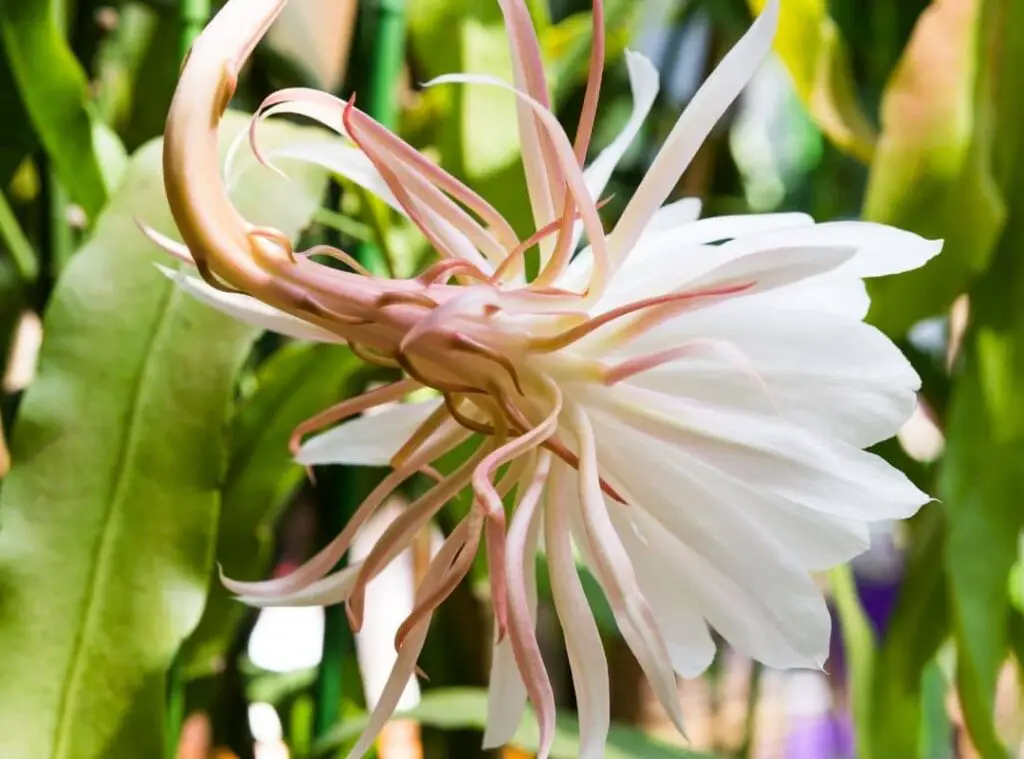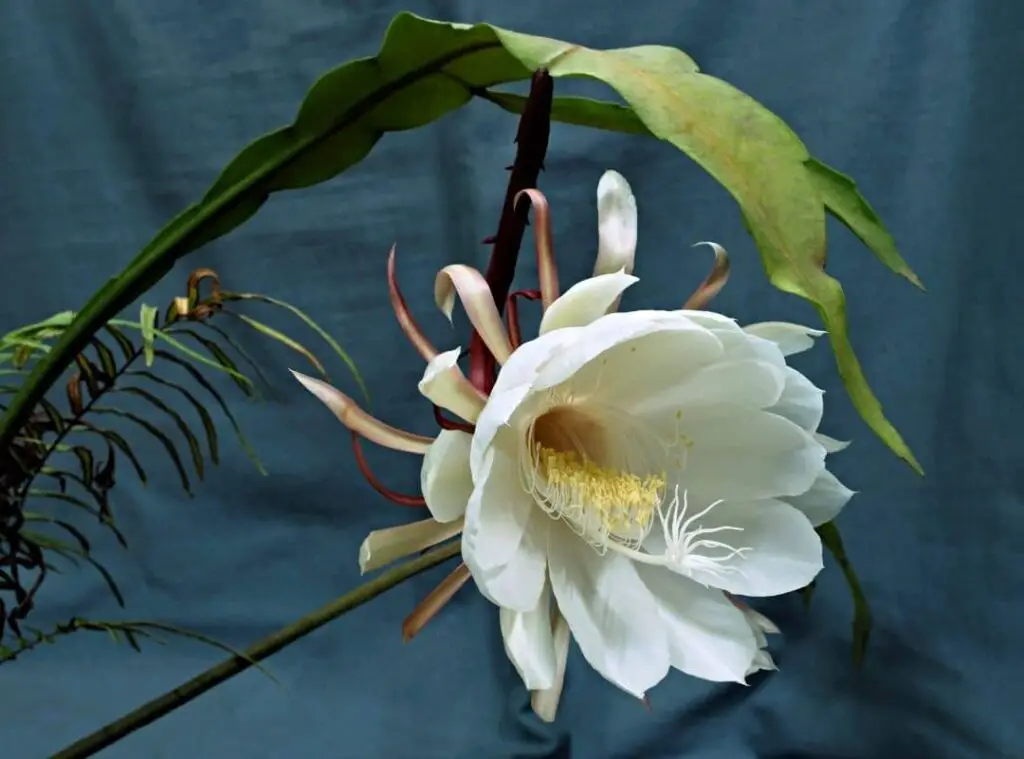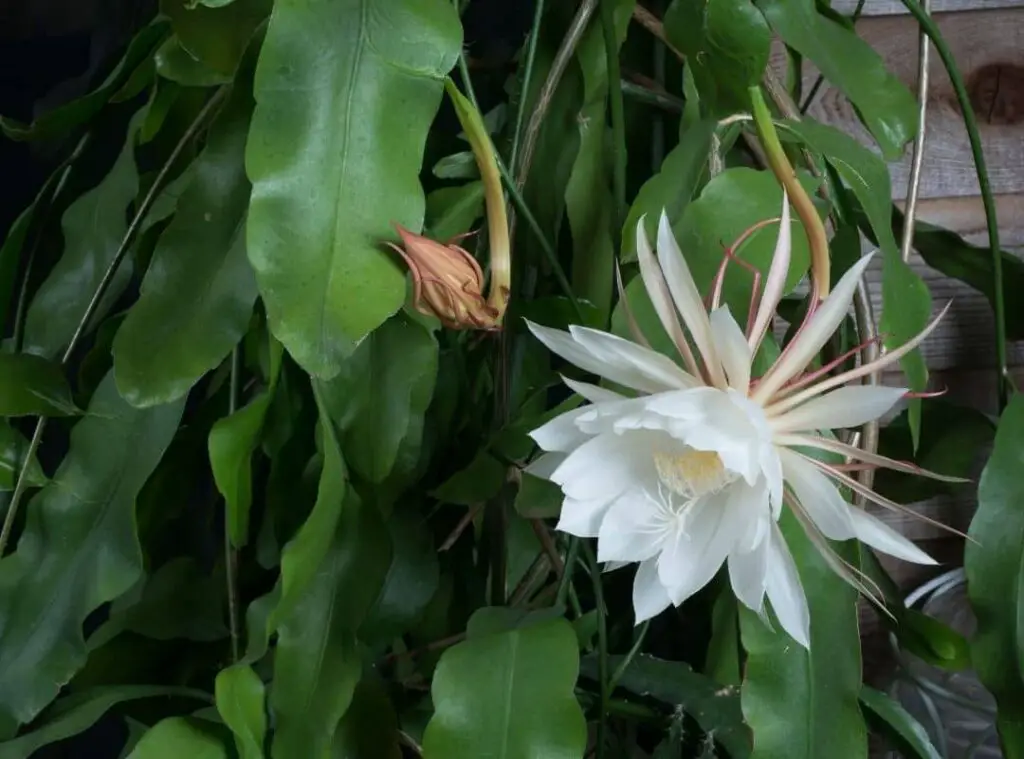Epiphyllum oxypetalum are endemic plants to southern Mexico and to South America. The common names of the Epiphyllum oxypetalum are Queen of the night, Orchid cactus, Jungle cactus, Night-blooming cereus, Dutchman’s Pipe.
It is one of the most common and largest cultivated species among the succulents’ enthusiasts.
They grow as epiphytic which literally means they grow on another planet’s surface when they grow in the wild.
As aforesaid these are getting trendier as house plants, and you would commonly find them grown in hanging baskets.
Epiphyllum oxypetalum are famous for their fragrant flowers and for their night blooming ability that makes them even more attractive. Following is a comprehensive guide on how to look after them well.

How do I identify Epiphyllum oxypetalum?
They would rise to 20 feet in height when they grow naturally. Their branching occurs in an erecting manner, and they further consist of cylindrical stems. Epiphyllum oxypetalum leaves will be scalloped and dark green in color.
Epiphyllum oxypetalum comes up with spectacular blooms which have a sweet fragrance. They are white and tend to resemble the look of a spider.
Besides, they could be star shaped and have a tinge of yellow. Those blooms have about 25-30 petals which are white.
In fact, their blooms could grow so big and could be as big as 6 inches ( 15 cm) in size.To further elaborate on the flowering, you could spot them flowering around 8-10 p.m. in the night.
However, they will close down as the dawn arrives. Hence , it is a little difficult to spot them flowering.
One look care guide
| Botanical Name | Epiphyllum Oxypetalum |
| Common Names | Queen of the night Orchid cactus Jungle cactus Night-blooming cereus Dutchman’s Pipe |
| Plant Type | Succulent |
| Mature Size | 20 feet tall |
| Sun Exposure | Full sunlight to partial shade |
| Soil Type | Well draining |
| Soil pH | Acid, Alkaline, Neutral. |
| Bloom Time | Late spring through summer |
| Flower Color | White |
| Hardiness Zones | USDA Zones 10-11 |
| Native Area | Southern Mexico and to South America |
| Toxicity | Non Toxic |
| Average price | 8 USD |
How do you take care of Epiphyllum oxypetalum?
Light Requirement
You should leave the plants in a spot where they can gain bright and indirect sunlight. Never expose them for direct sunlight.
Hence when you grow them as house plants, choose a bright lit place which could possibly be a window. However, if it is a glass window, ensure that you protect the plants from direct sunlight there.
If you wish to grow the Epiphyllum oxypetalum as outdoor plants, you can plant them in a location where they can gain bright sunlight and partial shade as well.
If the used location exposes the plants to harsh intense sunlight, you can use umbrellas and bedsheets and control the sunlight level.
The exposure for sufficient sunlight is crucial to stimulate the flower blossoming of the plants.
Ideally you need to balance the sunlight level exposure for them without overexposing them for intense sunlight or making them run short of it.

Temperature and humidity
Epiphyllum oxypetalum prefers to grow in warmer temperatures just like the many other succulents. Temperatures below 35 degrees Fahrenheit (1.7 degrees Celsius) would be unhealthy for them.
If you are experiencing much colder weather than that, you can relocate the plants indoors given that you do not place them closer to any vents or cod drafts
If you have grown them on the ground, you can consider covering them during colder times. To do that you can use old blankets or frost cloths for this purpose.
When doing that, ensure that the cover is not in contact with the cactus. Consider covering it in the late afternoon and remove it in the morning.
Humidity wise, Epiphyllum oxypetalum would prefer to have a steady level of humidity. You can consider using a humidity tray or mist them during winter so that you can control the humidity around the plants.
It is important that you water them more to control the humidity levels if you live in a dry area. Furthermore, you can arrange a water tray next to the plants to enhance the water levels.
Besides, you can use a humidifier also to enhance the humidity levels.
Is it cold hardy?
Epiphyllum oxypetalum are not cold hardy plants. These are used to grow in tropical weather. Hence, they do not handle colds well.
Epiphyllum oxypetalum do not tolerate temperatures below 35 degrees Fahrenheit.
USDA Hardiness Zone
The Hardiness Zone of The Epiphyllum Oxypetalum are USDA Zones 10-11.
Watering Requirement
Checking the soil status is quite critical before you water the plants. Simply because if you over water them, it will cause root rot in the plants. Having said that, do not leave them bone dry.
Instead leave some moist in the soil. Watering the Epiphyllum oxypetalum properly has a greater impact on the vigorous growth and the well being of the plants.
That will help the roots to form vigorously. Growing them in a well-draining soil mix and watering them properly go hand in hand.
If it is summer, you need to water them once a week since there will be hot and dry weather conditions around.
Additionally, grow them in containers which have sufficient draining holes. You need to reduce watering the Epiphyllum oxypetalum in fall and winter and water them once every two to three weeks.
Keep in mind that the matured plants require a less amount of water when compared to the young Epiphyllum oxypetalum plants.

Soil Requirement Type / ph.
Epiphyllum Oxypetalum requires a little more moisture in the soil than the rest of other cacti.
That is because they are used to grow in the rainforests where there are moderate steady humidity levels available. Hence do not leave the plant’s soil to become bone dry at any given time.
You can use cactus soil mix to grow the Epiphyllum Oxypetalum. The draining factor of the soil is crucial.
Hence why a cactus mix would go well with them. If you wish, you can make your own soil mix by mixing peat moss and ground “fir bark” in equal amounts and use.
Further you can mix two parts of ordinary potting mix along with one part of coarse sand and use it for Epiphyllum Oxypetalum.
Besides you can make another potting mix by blending two parts of potting medium with one part of perlite or pumice into one part of orchid chip or fir bark.
The purpose of adding perlite is to loosen the potting soil so that it will allow the water to drain faster.
Pot size Potting and Repotting
The right pot should be made out of a porous material such as a clay pot or a terracotta.
It will allow the roots to have a good aeration. When it comes to repotting, you do not have to do it quite often.
In fact they can survive in the same pot for a few years. Besides, they prefer to be pot bound so that it will stimulate the flower blossoming of the plants.
Where to Plant
A bright sunny spot which will allow the plants to gain bright indirect sunlight would be ideal for them.
A windowsill will suit these plants the best when you grow them indoors. Otherwise, you can leave them in patios, balconies or any other spot where they can gain filtered sunlight.
You can grow them as outdoor plants also given that you protect them from direct harsh sunlight.
Fertilizer and time of year.
Fertilizing the Epiphyllum Oxypetalum would be beneficial to boost the new growth of the Epiphyllum Oxypetalum plants.
To do that you can use organic matter to feed the soil. Alternatively, you can add a liquid fertilizer of 20:20:20. Moreover you may use a fertilizer which has a less component of Nitrogen as well.
You can feed them once a month in Spring to early Fall. Ensure that you are using a diluted fertilizer so that you can assure that your beloved Epiphyllum Oxypetalum plants do not get feed burns from Nitrogen.
If you provide excessive Nitrogen , it will make the stems grow but will badly impact on the flower blossoming of the plants. Suspend feeding them in winter to late fall.
Dormancy
Epiphyllum Oxypetalum go dormant in January and February.
Can be toxic to pets.
There are no records to show the Epiphyllum Oxypetalum are toxic for pets or for humans. In fact, this has been used as a medicinal plant by the ancient people in the tribes.

Common bugs and illnesses.
Epiphyllum Oxypetalum are vulnerable for fungal attacks and for root rot. For example, they may suffer from fungal leaf spots or from black rot diseases.
When there is black spots or brown spots present on the plants, it could be an indication of a fungal attack. In addition to them, they may come across pests’ attacks from mealy bugs, aphids, slugs and from mites too.
Over watering could be the root cause for all these issues as it makes the plant vulnerable for these pests attacks as well as for the disease.
To avoid these issues, ensure that you look after the plants well.
To treat mealybugs and mites you can splash water at them. When you do that ensure that you cover the soil as then it will not create waterlogged situations in the soil.
If there are any gnats present in the Epiphyllum Oxypetalum plants, you can use sticky traps. Moreover, you may use insecticides to overcome the pest attacks.
Special Care tips
Epiphyllum Oxypetalum requires easy maintenance from you. Having said that, looking after them well is crucial to make them flower.
Try to keep the plant’s pot bound so that it would stimulate the blooming of them. Ensure that you make them go through a cooling period in winter to make them bloom.
How to propagate Epiphyllum oxypetalum
Propagating the Epiphyllum Oxypetalum is simple.
- You can use leaf cuttings to propagate them.
- To start off, you need to cut off matured leaves which are looking healthy.
- Next keep them in a warmer place where they can develop callousness.
- When you use calloused cutting it will ensure that they will not go through any bacterial infection during the propagation process.
- Next, you may dip the leaf cuttings in a rooting hormone. This step is not mandatory to do, and you can do it only if you desire to have faster results.
- Rooting hormone will speed up the root formation.
- After that arrange a pot filled with a well-draining soil mix.
- You should avoid using a larger pot for the cuttings.
- Place the cuttings in the potting medium whilst placing the cut ends in the soil.
- Keep the specimen exposed for bright indirect sunlight.
- If you spot their soil is dry, you can water them.
- If you want to check whether the cuttings have formed roots, you may gently give a slight tug and check it.
- If you feel like they are resistant, that literally means the roots have formed.
- You could spot them forming the roots within two weeks.
- Place the specimen in a bright lit place but where they can gain filtered sunlight only.
Epiphyllum oxypetalum plant benefits
- Epiphyllum Oxypetalum plants have medicinal values as the ancestors in the tribes have used for their medicinal purposes.
- They have used Epiphyllum Oxypetalum plants to treat the rashes in them.
- Further the primitive Americans have used it to treat fever as well.
- Besides the Epiphyllum Oxypetalum stem is used to treat diabetes.
- Not only that but also, you can use it to treat hemoptysis and edema.
- Additionally, Epiphyllum Oxypetalum plants are used to reduce cholesterol and improve blood circulation.
- Apart from that, Vietnamese make a medicinal tonic from the Epiphyllum Oxypetalum flower petals.
- In addition to these medicinal values, they would be great additions for your containers, hanging baskets too.
Conclusion
Epiphyllum Oxypetalum are such appealing attractive sets of plants which are worth having. Try these gardening care tips and start growing our Epiphyllum Oxypetalum plants !
Read Next : Important Epiphyllum Diseases | 07 Major Issues You Might Face |
